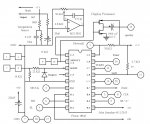I have a complex project which worked Ok until I put C.0 low (it connects to a SSR) Then it went haywire. C.0 was being held high
not by itself, but internally, and it took about 30 MA to bring it down. After checking the circuit, I switched to a spare chip, and that fixed the
problem. I discovered a 5 us neg pulse on C.0 at the 1 sec period of the DS1307 square wave which paces this device. This pulse I
think is the same as one on B.2. The bad 18M2 works OK in a bare breadboard, so maybe it cannot tolerate some of the items in the actual circuit, which include:
2 ADC inputs, two pins with pulsout, I2C and continuous PWM.
not by itself, but internally, and it took about 30 MA to bring it down. After checking the circuit, I switched to a spare chip, and that fixed the
problem. I discovered a 5 us neg pulse on C.0 at the 1 sec period of the DS1307 square wave which paces this device. This pulse I
think is the same as one on B.2. The bad 18M2 works OK in a bare breadboard, so maybe it cannot tolerate some of the items in the actual circuit, which include:
2 ADC inputs, two pins with pulsout, I2C and continuous PWM.

